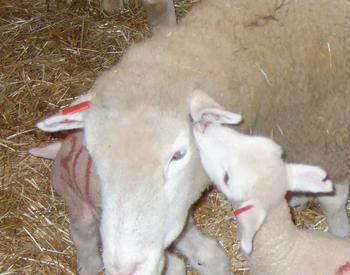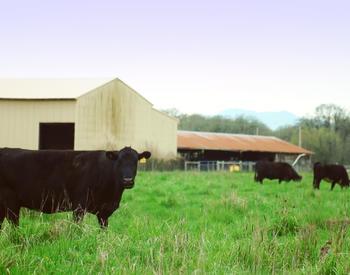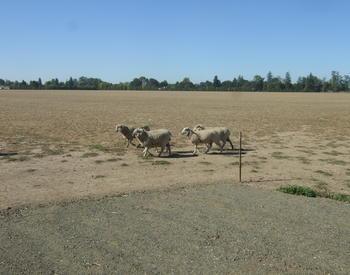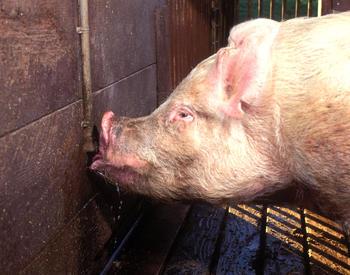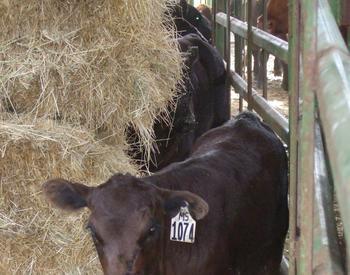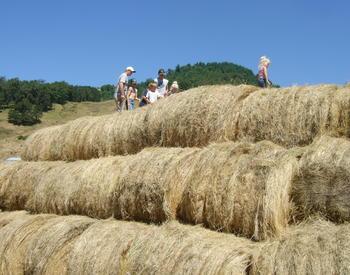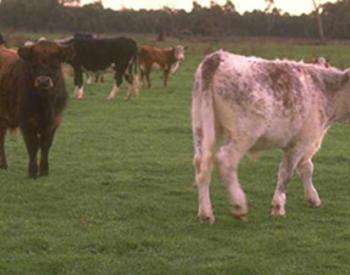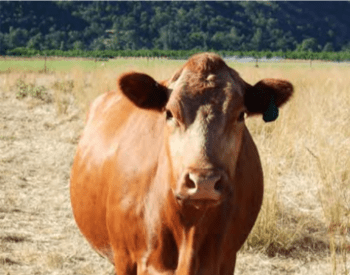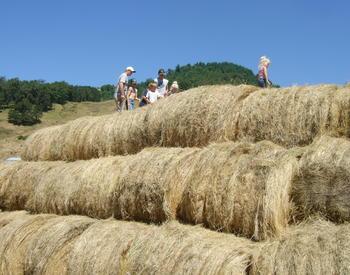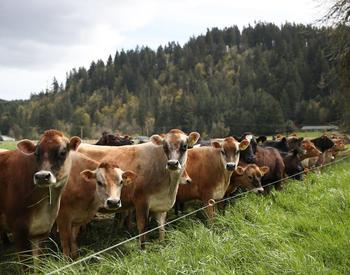When drought conditions are in the forecast for Oregon and other states, it’s time for livestock managers to start making contingency plans for buying feed, using alternative feeds, selling livestock and weaning early. Also, grazing management should help keep pastures strong and more likely to survive drought and continue to produce well in later years.
Purchasing feed
Hay is usually best to purchase early in the year in case people sell out. Although sometimes the price goes down late in the year if there are excess hay stocks. In a drought year, use caution and do not to wait too long.
Check out:
- The Market Report for hay prices around the country.
- The USDA Hay Quality Guidelines used in those market reports.
- The Oregon Hay and Forage Association Hay Directory with dozens of hay producers and haulers.
There are other sources of hay that can be found out in the countryside.
- The OSU Extension Service website collection on Services – Hay and Pasture has more ideas for where to purchase hay and current market prices.
- Google “hay for sale” and you can find several listings.
- Contact your local livestock association members and ask them for resources.
Not a member of a livestock association? Now would be a good time to join. There are so many benefits to belonging to these organizations. See Producer Organizations for contact information.
Don’t limit your purchases to grass or grass-legume mixtures. Consider using alfalfa hay as an option. Usually higher in protein and energy than grass hay or grain hay, it is sometimes available at a lower cost.
Some fair quality alfalfa (less protein than premium and good quality alfalfa) or even rained-on alfalfa hay might meet the nutrient requirements of your livestock, just make sure it is not moldy. OSU recommends producers never feed moldy hay to livestock. Oat hay can usually be found on the market and is a viable alternative if used in a ration balanced to meet animal nutrient requirements.
Alternative feeds
Grass seed byproducts
Another option in times of forage shortages is to feed grass straw or grass seed screening pellets from the Willamette Valley. If you choose to buy fescue or ryegrass straw or seed screenings, make sure they are not from harmful, high-endophyte varieties.
Choose this byproduct from a non-endophyte, a low-endophyte or a “friendly” endophyte variety of the grasses. As you may know, endophytes are a type of fungus that helps protect the plant from disease. The turfgrass-type fescues for lawns and golf courses have endophytes that release endotoxins (ergovaline and lolotrim B) that are problematic for livestock.
There are novel or friendly endophyte forage varieties that are not harmful to livestock, but these are special cultivars. You should confirm or test products for endotoxins and blend them with other feeds for a total diet with a tolerable concentration.
Alternatively, you could feed no more than 50% grass seed screening products. Check labels on feed bags as they have feeding instructions. Information on endophyte testing and tolerances by livestock is available through OSU.
Residual forage
Although the nutritive value of mature forage that is standing in the field can be very low, cows, sheep and other ruminants can use this if they're also fed a small amount of supplemental protein.
Consider renting mature pasture and supplementing it with alfalfa hay or another protein source (for example, soybean meal or cottonseed meal).
You don’t have to feed the protein supplement every day. Protein supplements are actually used more efficiently if you feed a double dose every other day, or three times the daily amount every three days. This improves both labor costs and feed efficiency.
Grain
Feeding some grain is a way to decrease the amount of forage needed to winter (or summer) livestock. Depending on the cost of grain and hay, it may or may not be more expensive. Feed grains in long feed troughs with ample room for all animals to eat at the same time and to avoid bossy cows or ewes from eating more than their share. Split barrels or large diameter conduits in half or construct wooden feed troughs.
Slowly adapt animals to grain diets by substituting a few pounds of grain for a few pounds of hay. Every few days, increase the amount of grain in the diet until you reach the desired grain level. This could be done over a period of two to three weeks. Generally, your goal for a full-sized cow should be to substitute 10 pounds of grain for 15 to 20 pounds of forage. In finishing rations, ruminants can be fed more grain than this but still require a diet that is at least 10% forage (pasture or hay) for a functional digestive system. Remember though, the current strategy is for saving on hay, not fattening the livestock.
An example ration is for a 1,200-pound cow that usually eats about 30 pounds of hay (2.5% of her body weight) each day. She could be transitioned from an all-forage diet to a diet of 15 pounds of forage and 10 pounds of grain. If you need to feed more grain, slowly adapt her to the diet over time.
A high-grain diet contains more energy than mature cows need. Although the cow's need for feed will be satisfied, she will probably gain weight on this diet. The animals will probably vocalize because they feel hungry due to the lack of fill, but they should get used to the new amount of feed in two to three weeks.
Wet brewers grains
These and other byproducts can be used to feed livestock, but their nutritional value may vary from batch to batch, and they usually require special storage or rapid use to avoid spoiling. Additionally, the supplier may require you to pick up the product on a regular schedule. For more information, see Wet Brewers Grains for Beef Cattle from University of Florida.
Make any diet changes slowly so as not to upset the animal’s digestive system, especially if adding grain. Major changes should be done gradually over a two-week period.
Five ideas for planning during a drought
Testing feeds and balancing rations
You should test your hay and byproducts feeds for nutritive value. New feeds or feed combinations will require new knowledge on how to balance the diets for the livestock you are feeding. See Matching Hay Quality with Animal Nutrient Requirements for an overview. For detailed information you will want to follow the OSU Beef Cattle Nutrition Workbook, in particular:
- Animal nutrient requirements (Chapter 1).
- Lists feeds, testing, and nutritive values (Chapters 2 and 3).
- Information on supplemental feeds cost and analyses (Chapter 6).
Many OSU Extension Service county offices have hay probes you can borrow to sample the hay. Send the samples to a lab for analysis.
Consider costs
If you are feeding animals with low nutrient requirements (dry cows and ewes, maintaining bulls and rams, over-wintering calves), good quality hay alone will probably be the least expensive ration.
But, if you are feeding animals with higher requirements (lactating cows and ewes, replacement heifers and ewe lambs) or using low-quality forage (poor quality hay or grass straw/screening pellets), you will need to add supplemental protein and energy.
If feeding low-quality hay, using grain may cost less than using higher-quality hay (alfalfa or high-quality grass hay) to make up the additional nutrients required for satisfactory animal performance. Check prices and make calculations carefully before choosing a ration.
Reduce animal numbers
Consider culling undesirable animals. Have your veterinarian pregnancy-check your cows and ewes and get rid of the open ones when market conditions are favorable compared to feed costs.
Cows are normally culled in the late summer or early fall after calves are weaned, so the market is flooded, and prices are lower at that time compared to the winter or spring months.
See more on culling sheep. For cattle consider genetics (Fitting the Cow Herd to the Environment), reproduction (Reproductive Management of the Cowherd), and temperament (Evaluating Temperament in Beef Cattle).
Early weaning
If forage is in short supply or cow body condition is low, calves can be weaned early (before seven or eight months). This preserves cow energy reserves to allow for development of the new calf inside her and keep her in good shape for timely re-breeding after that calf is born.
Studies have shown that in times of forage shortages, it can be economical to wean calves early. In those cases, the cost of feeding early weaned calves was more than offset with improved reproductive performance of cows that were kept in a body condition that favored efficient reproductive performance.
See more from OSU Extension about weaning beef calves and baby lambs.
Protecting pastures
Careful grazing management now and this fall can help keep pastures strong and resilient for survival and drought recovery. The recurring theme in many forage publications points to leaving an appropriate post-harvest stubble height (2 to 4 inches, even 6 inches) for the specific type of grass (ryegrasses, fescue, orchardgrass) growing in the pastures. There are at least three different reasons for this.
- The above ground stubble, the crown, stores energy for plant maintenance and regrowth.
- Ample leaf tissue remaining on a plant is used for capturing solar energy by photosynthesis for growth and replenishing energy in the crown after a growth event.
- Deep root growth reflects good above-ground growth and is important for reaching moisture and nutrients deep in the ground.
Graze too short and you hinder the ability of plants/pasture to regrow. Many pasture forages are perennials and are only dormant, not dead, during the summer. Be careful not to overgraze pastures now and they will repay you with forage later. For more information on grazing management and drought, see the following publications and fact sheets:
- WSU Drought Advisory: Managing irrigated pastures and grass hay land.
- Overgrazing: The sin of all sins.
- Understanding plant root growth in fall.
Whether you find enough hay or not, we hope you can use the tips in this article for using feeds wisely.

